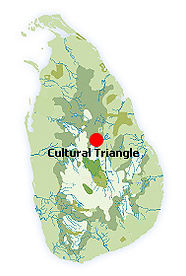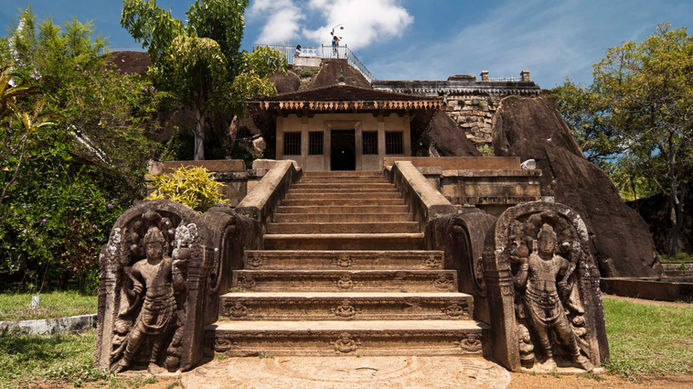ANURADHAPURA
Anuradhapura is one of the island’s most famous ancient cities, firmly in place in any tours in Sri Lanka.The ancient ruins predating the Christian era puts Anuradhapura in the pantheon of human history along with Athens, Alexandria and Patalipurhra. It depicts the trajectory of the Sinhalese civilization from the time it was founded in 4th century BC.The Mahavamsa, the historical chronicle affirms that the city was founded in 380 BC. The capital city of Sinhala Kings of Sri Lanka suffered, survived, was razed to the ground and was rebuilt as most other cities whose prosperity and the envy of rulers in its proximity was a recipe for recurring disasters and innovative engineering in reconstruction.The past grandeur is narrated by a fascinating collection of ancient ruins some of which have been painstakingly restored. The remote past of a majestic capital and a monastic city of benevolent kings, despotic monarchs, retreating rulers and heroic conquerors reach out to you from Sri Lanka history.The Dagoba – Thuparamaya was built by King Devanam Piya Tissa in 3rd century BC to enshrine the clavicle of the Buddha, considered a sacred relic that was gifted to the King by the Mauryan Missionary Emperor Asoka. The city was conquered and sacked by Pandyan kings in the 9th century. The destruction in AD 993 by an invading Indian King brought an end to the city as the capital of Sri Lanka. Close to Anuradhapura is Mihintale, the oldest and the first wildlife sanctuary of all mankind. The story goes that King Devanam Piyatissa who was a deer hunt when he found Arahant Mahinda and by royal edict declared the entire area as a protected reserve a tradition that continues to this day. Other than Mihintale, there are more than 14 protected wild life parks you can visit on your Sri Lanka trip.
The oldest tree in the world adorns this city of shrines. It was brought from India in the 3rd century BC. Its sanctity rests on it being grown from the Bo Tree (ficus religiousa) in Bodhgaya India. Under the shade of the parent tree, the Ascetic Siddharathe sought enlightenment.The relicts of the Buddha enshrined in Stupas or Dagobas have thus determined the topography of Anuradhapura.Your holiday in Sri Lanka needs to an enriching experience. Find the answer to the question “can man escape his destiny?” Yes. See the Samadhi Statue of the Buddha, matchless in the intense serenity that it radiates.Can a royal bath be made as ornate in its scale and beauty as that of a cathedral? Yes, See the twin ponds. To learn about Sri Lanka is to learn about the genius of man.

Anuradhapura Information and Google Map
PROVINCE : NORTH CENTRAL PROVINCE
DISTRICT : ANURADHAPURA DISTRICT
POPULAR : ANCIENT RUINS
WEATHER : 32 °C
PHOTO GALLERY
Cultural Triangle
The Cultural Triangle is found on Sri Lanka’s central plains and encompasses Anuradhapura, Polonnaruwa, Sigiriya, and Dambulla. It is here that the country’s kings gave rise to a great civilization based on agriculture and Buddhism. These kings also treasured the ancient healing wisdom of Ayurveda, which remains a preferred health care in rural areas. Anuradhapura, Sri Lanka’s first capital, was the greatest monastic city of the ancient world and was ruled from the 4C BC to 11C AD by more than 100 Sri Lankan kings. Polonnaruwa became Sri Lanka’s royal medieval capital in 1073 where the Sinhalese king Vijayabahu I followed by Parakramabahu I, ruled. It remained Sri Lanka’s capital until the late 13C. Another significant event in Sri Lanka’s history is the introduction of Buddhism to this island in 247 BC: Mihintale is especially inspiring on a full-moon day.
Food & Drink
Sri Lankan rice and curries and western cuisine is served in all the hotels within the Cultural Triangle. Heritance Kandalama is highly regarded for its award-winning cuisine ranging from lunch time buffets to fine dining. Vil Uyana’s Apsara restaurant with views of the Sigiriya rock, offers a la carte menu as well as a vegetarian menu. Mid-range hotels tend to rely largely on buffets; Chaaya Village’s wide choice and good quality gets excellent feedback. More details are in our hotel profiles. There are several wayside eateries and stalls on the way to the Cultural Triangle where a cup of tea or a Thambili (king coconut) – a great thirst quencher, or a cool drink can be purchased.
Shopping
The cultural triangle is not the area to plan a shopping expedition. Watermelon, pumpkin and other dry zone vegetables grown in village gardens as are found in wayside stalls. Groceries, pharmacies, and banks are available in the main towns. Buddha statues are available for purchase in Anuradhapura, Polonnaruwa and Dambulla.
Events
Vesak in Mihintale: takes place on full moon day in May with remembrance of Lord Buddha’s birth, enlightenment and Prinivanpama (his passing). In June, the festival of Poson is celebrated in remembrance of the introduction of Buddhism Sri Lanka by Mahinda.
Sights
Sri Lanka’s Cultural Triangle – as the name suggests – is home to a large proportion of historical cultural sites, including some of the island’s most famous and well-preserved ruins such as the medieval city of Polonnaruwa and the 5th century Sigiriya Rock Fortress. Read through our ‘Activities’ section to discover more about the ancient cultural sites in this region.
Activities

Sigiriya Rock Fortress
Sigiriya, a UNESCO World Heritage Site, is one of the most majestic, awe-inspiring and stunning historical locations in the world, built in the 5th century AD by ‘mad’ King Kasyapa.

Dambulla Cave Temple
The most famous cave temple complex in Sri Lanka, the ancient Dambulla Cave Temple boasts the largest number of Buddha statues to be housed in one place, as well as stunning ceiling paintings.

Polonnaruwa
Sri Lanka’s medieval capital from 1073 until the late 1200s, the ruins of the Kingdom of Polonnaruwa are incredibly well-preserved and include magnificant granite sculptures of Lord Buddha.

Anuradhapura
Discover the majestic remains of Sri Lanka’s first capital, originally built in the 4th century BC and the ruling place for over 100 Sri Lankan kings. You can explore these extensive ruins by bike or on foot.

Yapahuwa
Yapahuwa, an enormous yet little-visited rock fortress built in the 13th century around a vast grantic rock which rises 100m above the surrounding plains.

Aukana
One of the most spectacular statues in Sri Lanka, the Aukana Buddha has stood 12m high since it was made in the 5th century. It is free-standing, carved from a single rock.

Mihintale
Mihintale was recorded as being the birthplace of Buddhism in Sri Lanka in 3rd century BC. The peak is home to magnificent pieces of ancient Sri Lankan architecture and a majestic 40ft dagoba.







